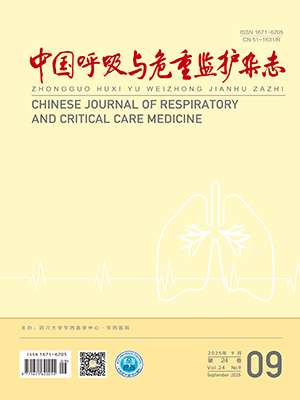| 1. |
中华人民共和国国家卫生健康委员会. 新型冠状病毒肺炎诊疗方案(试行第七版) [EB/OL]. [2020-03-04]. http://www.nhc.gov.cn/yzygj/s7653p/202003/46c9294a7dfe4cef80dc7f5912eb1989.shtml.
|
| 2. |
向天新, 刘家明, 许飞, 等. 江西地区 49 例新型冠状病毒肺炎患者临床特征分析. 中国呼吸与危重监护杂志, 2020, 19(2): 154-160.
|
| 3. |
李欣, 荆小莉, 关开泮, 等. SARS 中淋巴细胞变化与肺损伤严重程度的关系. 热带医学杂志, 2005, 5(6): 795-795, 821.
|
| 4. |
王蓉, 谢伶俐, 杜鹏, 等. 新型冠状病毒肺炎 96 例临床分析. 中国呼吸与危重监护杂志, 2020, 19(2): 144-147.
|
| 5. |
Zhang JJ, Dong X, Cao YY, et al. Clinical characteristics of 140 patients infected with SARS-CoV-2 in Wuhan, China. Allergy, 2020, 75(7): 1730-1741.
|
| 6. |
刘敏, 贺鹏, 刘辉国, 等. 30 例医务人员新型冠状病毒肺炎的临床特征分析. 中华结核和呼吸杂志, 43(3): 209-214.
|
| 7. |
Yang WJ, Cao QQ, Qin L, et al. Clinical characteristics and imaging manifestations of the 2019 novel coronavirus disease (COVID-19): a multi-center study in Wenzhou city, Zhejiang, China. J Infect, 2020, 80(4): 388-393.
|
| 8. |
陈蕾, 刘辉国, 刘威, 等. 2019 新型冠状病毒肺炎 29 例临床特征分析. 中华结核和呼吸杂志, 2020, 43(3): 203-208.
|
| 9. |
陈夕, 童瑾, 向建华, 等. 139 例新型冠状病毒肺炎患者流行病学特点对重症化影响的回顾性研究[J/OL]. 重庆医学, [2020-03-13]. http://kns.cnki.net/kcms/detail/50.1097.R.20200313.1537.004.html.
|
| 10. |
Kolber W, Kuśnierz-Cabala B, Maraj M, et al. Neutrophil to lymphocyte ratio at the early phase of acute pancreatitis correlates with serum urokinase-type plasminogen activator receptor and interleukin 6 and predicts organ failure. Folia Med Cracov, 2018, 58(4): 57-74.
|
| 11. |
Chandrashekara S, Mukhtar Ahmad M, Renuka P, et al. Characterization of neutrophil-to-lymphocyte ratio as a measure of inflammation in rheumatoid arthritis. Int J Rheum Dis, 2017, 20(10): 1457-1467.
|
| 12. |
Qin C, Zhou LQ, Hu ZW, et al. Dysregulation of immune response in patients with coronavirus 2019 (COVID-19) in Wuhan, China. Clin Infect Dis, 2020, 71(15): 762-768.
|




